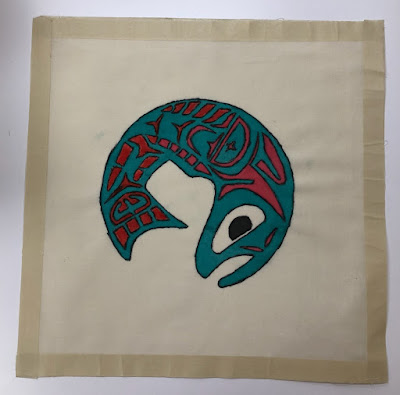This was a very meaningful multi grade collaborative project our school completed recently. It was initiated by one of our Grade 6 Social Studies teacher. She has a background in quilt-making and has a personal interest in Indigenous culture and reconciliation.
The Truth and Reconciliation Commission of Canada (TRC) was created through a legal settlement between Residential Schools Survivors, the Assembly of First Nations, Inuit representatives and the parties responsible for creation and operation of the schools: the federal government and the church bodies.
The TRC’s mandate was to inform all Canadians about what happened in residential schools. The TRC documented the truth of Survivors, their families, communities and anyone personally affected by the residential school experience. This included First Nations, Inuit and Métis former residential school students, their families, communities, the churches, former school employees, government officials and other Canadians.
Reconciliation can be a touchy subject in my province of Alberta with many Conservative politicians and people trying to downplay it. I'm thankful I work with colleagues who are passionate about including First Nations topics in our school including difficult ones such as reconciliation and residential schools.
I've done some other Canadian Indigenous lessons in the past:
See my Blackfoot
Winter Count Buffalo Hide Designs art lesson
HERESee my
Norval Morrisseau Style X-Ray Paintings HERE
For this collaborative quilt project, students from Grade 4,5 and 6 worked to colour in a square for the quilts. An indigenous representative helped the Socials teacher select the indigenous imagery used and ensured they were appropriate. They strove to represent The First Nations, Metis and Inuit of Canada with each image chosen and to honour each indigenous group.
The images were printed off and the students traced them onto pre-cut canvas squares. The edges were taped off.
Once traced in pencil, the images were coloured using fabric markers. While students worked on the art, the teacher shared the symbolism of the images she has learned from Knowledge Keepers.
Once all the fabric squares were coloured, some students ironed and prepared the material for sewing. A parent volunteer helped the Socials teacher sew all the material together. Finally, a local quilting company, Loopy D, was utilized to to sew the quilt patterns on top of the quilt.
During a division wide assembly, one of the quilts was gifted to a local Indigenous Education Consultant (from the Cree and Carrier First Nations) who worked with our students last year, teaching traditional Indigenous games on National Indigenous Peoples Day. He was very touched by the gift and gave us a mini lesson on the history of gifting blankets within his culture.
For First Nations people, a blanket holds deep meaning and traditions linked to culture, birth, life and death. Blankets are given at weddings and upon the birth of a child. They are also given to recognize elders and those involved in a worthy endeavour. Some blankets used at pow-wows are changed into shawls by adding satin appliqués and ribbons. First Nations peoples’ use of blankets is multidimensional, shaped by their experiences, and can be passed to future generations. (Source)
I love how they all turned out! Making these ten quilts connected everyone and helped us learn about caring for one another by accepting other cultures in Canada.
Here are the specific steps as generously provided by my colleague:
Quilt Process
Step one: With the help of an Indigenous Consultant, images were researched together to ensure they were appropriate. Copies were made of these images.
Step two: Beige fabric squares were prepared (cut 14inch by 14 inch and taped along the edges to prevent fraying).
Step three: Using a pencil, the paper copies of the images were placed under the fabric squares and traced.
Step four: Fabric markers were then used to colour in the images.
Step five: The images were heat-treated (ironed).
Step six: Images were carefully selected and grouped to highlight each piece.
Step seven: Fabric was chosen to bring out the gorgeous artwork.
Step eight: Fabric was cut to size for sewing together and the tape was removed from the fabric squares, which were then “squared up”.
Step nine: The images were sewn to the fabric sashes. These were each heat treated to ensure a smooth seam.
Step ten: Batting was cut (a little larger) than the top of the quilt.
Step eleven: The backing was cut a little larger than the top layer and the batting and all three sections were pinned together.
Step twelve: Time for the long arm quilting machine to work it’s design magic onto the quilt.
Step thirteen: Cut fabric 2.5inches wide and in long strips, sew these together on the bias to create the binding.
Step fourteen: The quilt is ready for “squaring up” before the final touch.
Step fifteen: Sew the binding (back of the quilt first, iron and then sew the front of the binding onto the top of the quilt)























No comments:
Post a Comment